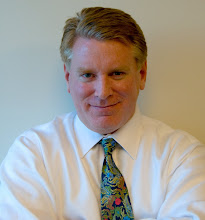The following article appeared in the May 15, 2009 issue of American Banker. It was my eulogy to Bill Seidman, a great American.
As with any public figure, there were two (or more) sides to Bil Seidman. He was your basic consummate professional / belt-way insider / banker / lawyer / Regulator / Inflation-fighting / C-suite turned TV personality curmudgeon.
‘Losing him is bad for me, its bad for anyone who came to know and love him, and its bad for America. He kept us anchored to what banking really was and is and should always be; a bank 'takes deposits and makes loans' said the Chairman to me one night at dinner.’And he was a cowboy.
Not a cowboy in the sense of an out-of-control, balance-sheet-wielding wall street transaction-driven loose cannon - I mean he was a Cowboy. A deyed-in-the-wool, horseback riding man on a horse; he loved horses. Bill wore boots, and Bill knew exactly how to wear boots; (real boots, worn under saddle and put up wet).
Once he arrived in Washington, as part of the "Whip Inflation Now" (WIN) team in the Nixon Whitehouse, he gave up horses but kept riding; a bicycle. Seeing him getting ready to leave his P-Street office on the way to CNBC back in the early-'90's became a tourist attraction around Georgetown. He was clockwork (even at the risk of being late, no car necessary); when it was time to get in front of the camera and talk about - well, no one ever really knew WHAT was going to come out his mouth in those early days (... or any days really) - but when his public called, he showed up and he delivered. He said it like it was and it turns out people were actually watching,; who would have known.
As a young banker, just out of FDIC/RTC "experience" (when the word "resolution" came to mean "best don't be at work" at an S&L on a Friday afternoon) - getting to meet, then getting to be around and then getting to work with "The Chairman" was a privilege beyond words. Every encounter was an experience in why America works; good old fashioned mid-west common sense (he was a Romney-ite, and I don't mean Mitt). He spoke, we listened, we learned. He was tough with us; tough as nails; there was a "no BS" zone around him the size of Michigan.
Losing him is bad for me, its bad for anyone who came to know and love him, and its bad for America. He kept us anchored to what banking really was and is and should always be; a bank "takes deposits and makes loans" said the Chairman to me one night at dinner.
Before you go back to work tomorrow, think about that for a moment.
Bill didnt' like the idea of little banks growing in to big ones fast, but nonetheless had a penchant for the under dog, the little guy. One look at the "portfolio" of relationships he cultivated shows where his heart was. He was an entrepreneur at heart who admired a can do attitude and a dream to match.
I know this, because I had one of those dreams, as President (at the age of 34 when I did not understand why a deposit was a liability) of a small insured institution outside of Philadelphia back in 1995. The Chairman agreed to serve as our Advisory Board Chairman. We had three things going for us; an insurance certificate, $9 million of assets (and i mean, total assets), and a branch the size of a closet. We were successor to a century-old Quaker savings bank charter, which by some freak of provenance had become an FDIC insured institution.
So why would the former Chairman of the one of the world's most powerful regulatory bodies affiliate with - this ? ... when he could have chosen ANY major multinational financial services conglomerate for his satisfaction ?
L. William Seidman believed in main street (and, as it turns out, I was lucky to be a better horseman than he and able to captivate his competitive spirit; he was actually quite a Polo player in his youth and I had a few pair of boots in the closet too).
At any rate, I will miss the Chairman. He lectured me on the evil of derivitives, the lure of yield ("Ken, sometimes there just IS NO interest rate HIGH enough to reflect the REAL RISK in a loan !") and admonished me for putting ice in a glass of single-malt scotch (I stayed away from the ice after that, but I can't say the same for some loans that would have been better left undone). The people close to him, he kept in his heart for life - (Birge Watkins, Jackie Pace, David Cooke, Bill Roelle, Patrick Hanraty, Amy Krallman - so many other good friends and co-workers) - and a trip to Nantucket for the weekend could easily turn out a political and corporate entourage fit to rival Congress in session). He loved and admired the political machine, and after a few early steps toward office, taught me that a "successful day" in the White House was any day the President did not notice you were there (a useful skill-set).
He was a true, red white and blue banker; he was a friend, he was a savior to a generation of lost banks and bankers - he was a great American. He gave the Japanese Fleet the better part of his grit, he gave S&L asset-junkies the better part of his mind and he gave his country the better part of his life. The Chairman may be gone but Full Faith and Credit (yes, a book plug, what he would have wanted) is here for good.
